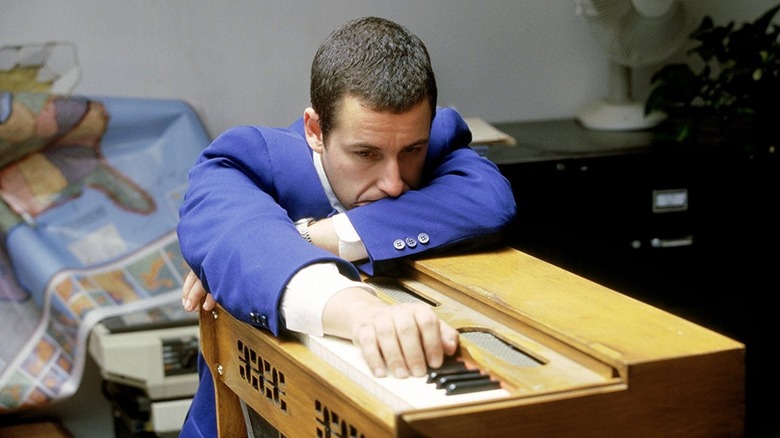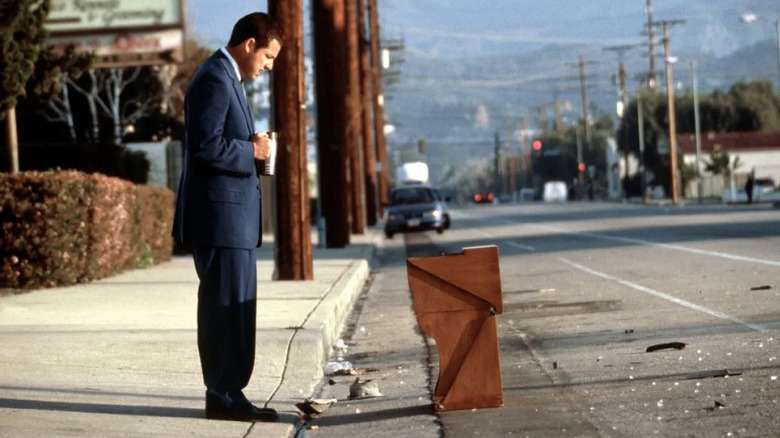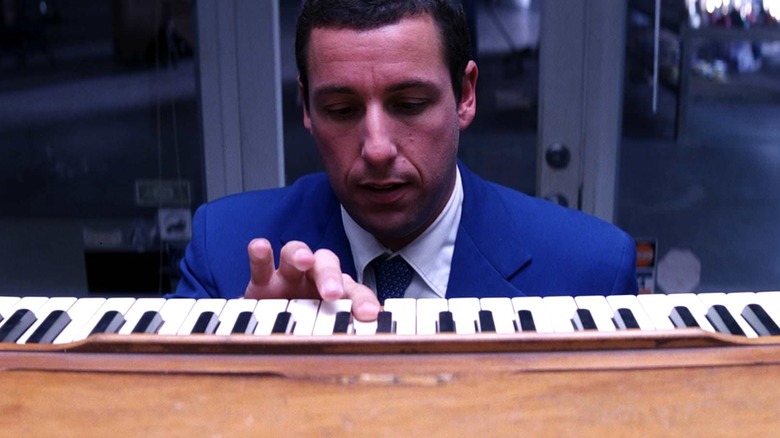How Adam Sandler Influenced The Soundtrack To Paul Thomas Anderson's Punch-Drunk Love
The harmonium in Paul Thomas Anderson's 2002 film "Punch-Drunk Love" enters the movie in a dramatic and unexplained fashion. It's just before dawn next to a wholesale warehouse somewhere in the San Fernando Valley. Barry Egan (Adam Sandler) has stepped out into the warm darkness to drink his coffee. A red truck down the street is approaching at incredible speeds. Unexpectedly, the truck — perhaps striking something — is flipped into the air, and violently cartwheels down the street, spraying shards of metal and plastic all over the road. A second vehicle, a red taxi van, pulls up next to the carnage, right in front of Barry. The door opens and a faceless man places a harmonium on the sidewalk. The taxi speeds off. In less than a minute, everything is quiet again.
Barry takes the harmonium inside.
Barry is an angry, lonely man who will spend the span of "Punch-Drunk Love" awkwardly beginning a sweet, cathartic relationship with a woman named Lena (Emily Watson). The harmonium — a small, bellows-operated keyboard instrument — will, of course, serve as one of the film's central symbols. Out of random violence and anger, music can exist. Occasionally, Barry will noodle around on the harmonium, figuring out a few note progressions that sound briefly pleasant to the ear.
The music for "Punch-Drunk Love" was composed by Jon Brion, who expounded on the role of the harmonium in a 2016 interview with Rolling Stone. Evidently, those idle noodlings that Sandler improvised on set proved to be a solid basis for the film's entire score.
Harmonium noodling
Jon Brion pointed out that there is no actual harmonium music in his score, but that all the motifs and chord progressions — like a TikTok duet train — were expounded from very simple notation. He said:
"Actually, there's a bit of Adam [Sandler] occasionally playing a note or two on it that kind of made its way in. I'd go to the set and sort of see what he could do with it, which influenced certain bits of writing I did, and his playing would end up underneath it. Even if he's playing something random, I'd drop bits into later pieces ... so in a way, the idea would be like he was slowly finding puzzle pieces of his future life when he noodled around."
Barry's idle music came straight from his heart, and it informed how he would grow as a person. That's very sweet. However great an idea it was, though, Brion was actually forbidden from actually putting any harmonium on the soundtrack. This was, it seems, quite a heartbreaking moment for the composer, as he was eager to finally, at long last, give the instrument its cinematic due. Paul Thomas Anderson put the kibosh on his dreams pretty quickly, sadly. As Brion said:
"When I first saw that Paul had one that was part of the story, I was like 'I get to make an all-harmonium soundtrack, yay!' I'd been obsessed with the instrument since I was a kid. I was waiting the whole time to be like, Okay, now here comes the big harmonium piece! This was going to be my big contribution: the most memorable use of the instrument in all of cinema! Nope. Any lofty aspirations on my most excitable day that I was going to get it in there — not going to happen."
The organ compromise
Luckily for Jon Brion, he was able to compromise. While Paul Thomas Anderson would not permit actual harmonium music onto the soundtrack for his film — his specific objections to the instrument are not made clear — he did allow his composer to make use of another similar organ-like instrument. This was fine, as it provided Brion with the whimsical, wheezy, toy-like sound he was seeking. Said Brion:
"There is a somewhat similar reed organ in the movie: Jim Keltner and I both share this obsession with kid's toys that make sounds, and each have pretty huge collections. He brought over a dreidel that had air vents and two little chords that were slightly out of tune. And if I spun it, it created this Doppler effect that had a little vibrato. If I pointed it out in the soundtrack, you'd totally recognize it; it's in the middle of a couple of the percussion pieces where there's a breakdown and then you hear this wheezing, harmonica-with-asthma sound."
Jim Keltner is a famed studio drummer who has played with three of the four Beatles, the Traveling Wilburys, Harry Nilsson, and many others. As for the musical dreidel, such toys are common enough and can be purchased at well-stocked toy stores or from any nearby online outlet. As for the reed organ, Brion described the sound as being weak and airy, which was just what he was looking for. He said:
"Think of the world's most anemic organ. It was part of our sound effects palette. It was slightly out of key with everything else, which Paul thought fit nicely with everything else. It made it beautiful, he said."
Brion's wonderful soundtrack is readily available online and is really sweet unto itself. Brion's whimsy shines through.


